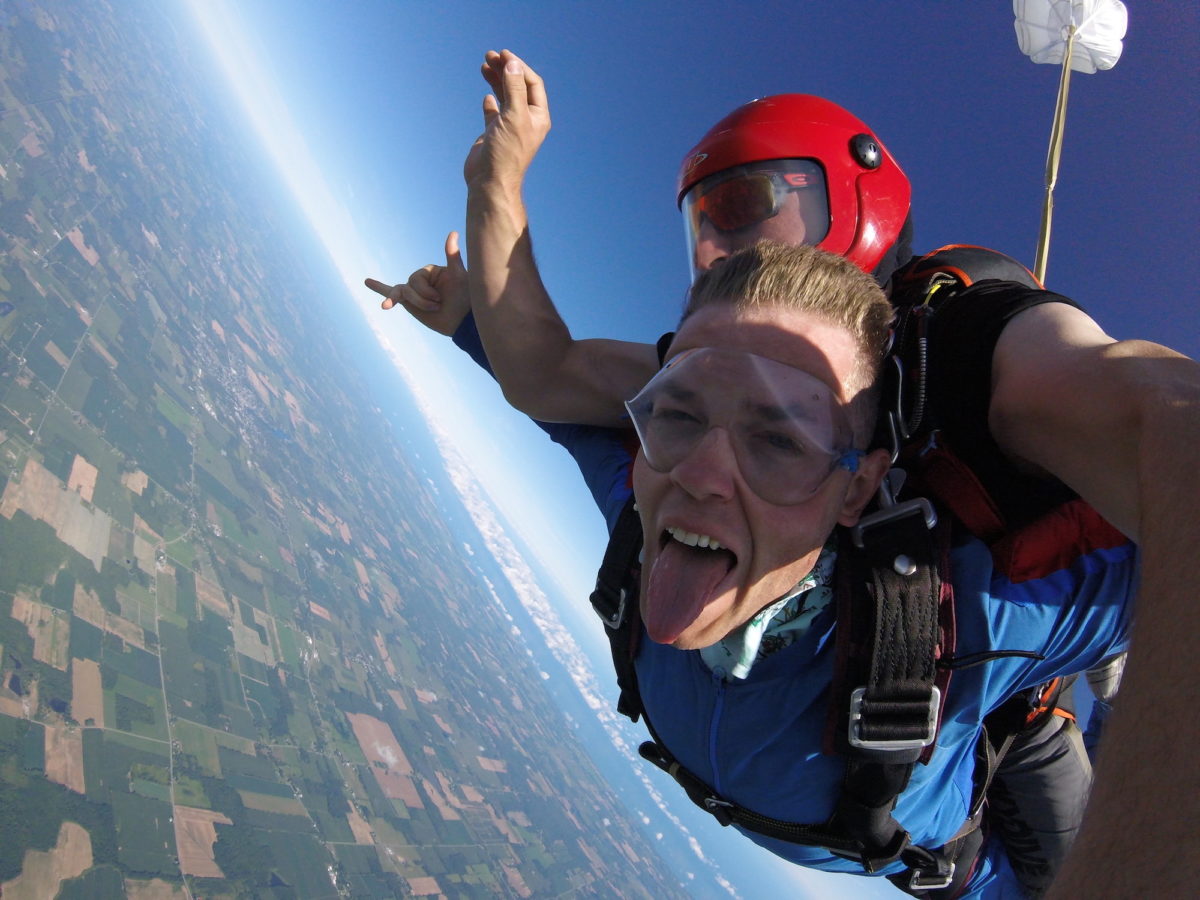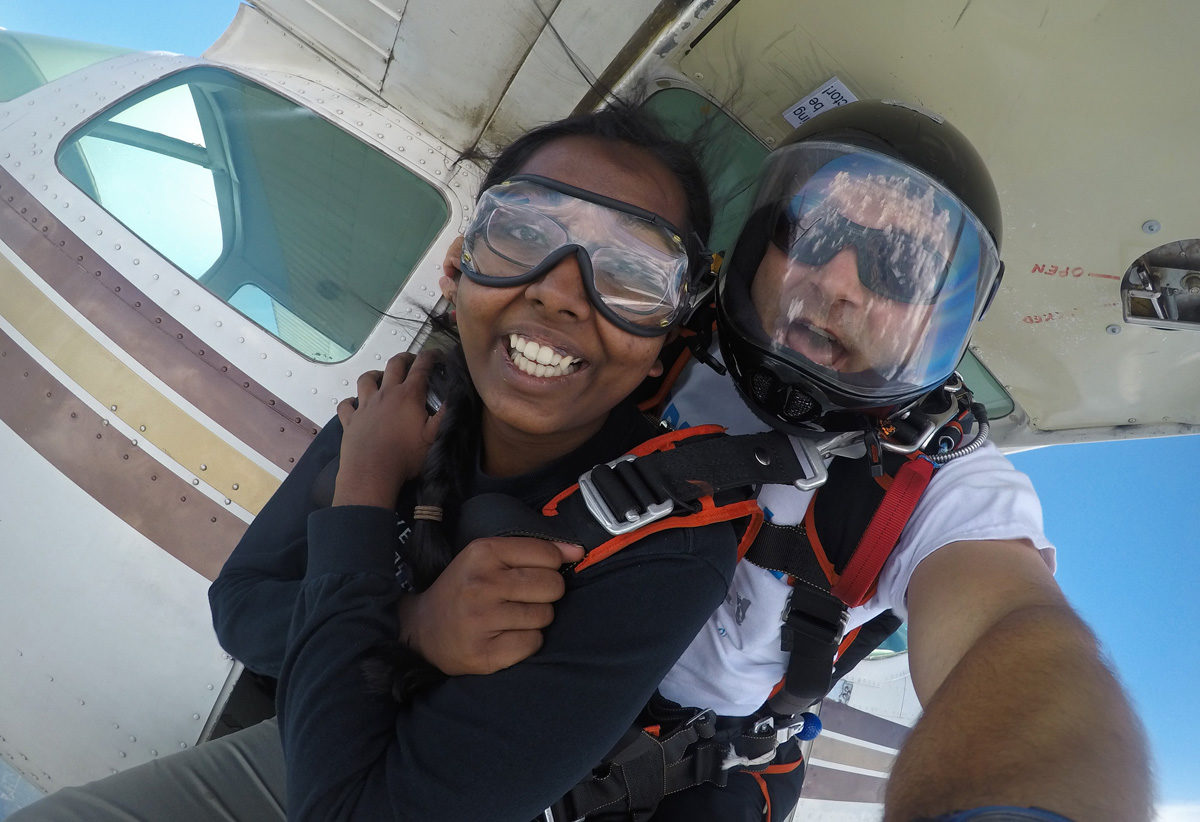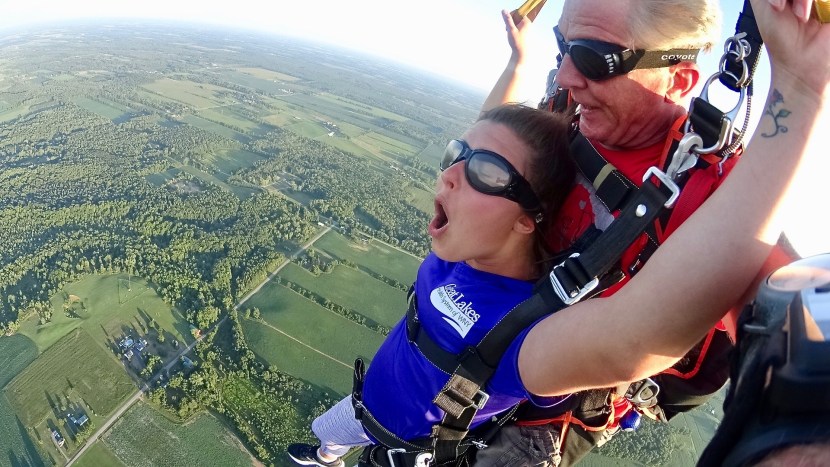Invented in 1983, tandem skydiving revolutionized the sport of parachuting by allowing people with no skydiving experience to make a jump with minimal training. Using a harness and parachute built for two, a professional skydiving instructor can facilitate a skydive for anyone who meets the age, weight, and health criteria to make a skydive safely.
At WNY Skydiving, we specialize in hosting guests from all over the world with no prior skydiving experience, thanks to tandem skydiving’s creator, Ted Strong.

How Much Does Tandem Skydiving Cost?
The price of a tandem skydive varies across the world but generally falls within the range of $200 and $300. Variables that affect price depend on the competitiveness of the market, aircraft type, and altitude. Some skydiving centers offer very cheap pricing based on a high volume model. A word to the wise: cheapest isn’t always best particularly with skydiving! Operating a skydiving center is not an inexpensive venture when considering the ongoing maintenance of aircraft and skydiving equipment.
Visit our pricing and group pricing page to review our tandem skydiving pricing options.
What are the Age Restrictions of a Tandem Skydive?
The minimum age requirement for United States Parachute Association (USPA) Group Member skydiving centers is 18. There are a couple of non-member skydiving centers in the US that permit minors to make a skydive, but are few and far between. Throughout the world, age restrictions vary from no minimum age requirement (New Zealand) to 18 here in the US.
There is no maximum age requirement. The current record for the oldest tandem skydiver is 103 made at Skydive Snohomish outside of Washington State!
What are the Weight Restrictions for a Tandem Skydive?
The most common weight restriction at the majority of skydiving centers in the world is 230lbs. The weight restriction should not be considered a hard and fast rule as a person’s height to weight ratio applies to how an individual fits in a tandem harness. For example, an individual who is 6’3” weighing 230lbs will fit in a tandem harness differently than a 5’4” individual also weighing 230lbs. It’s generally recommended that individuals over 210lbs be physically fit to make a jump. If weighing over 210lbs, it’s usually best to contact the skydiving center to discuss the viability of making a tandem skydive.

What Should I Wear For a Tandem Skydive?
It’s best to wear loose, but not baggy clothing for a tandem skydive. Generally, jeans and a tee-shirt during summer months works out fine. Tennis shoes or sneakers that are close-toed are ideal. Heavy shoes like cowboy boots or any boots with hooks are not recommended. Shoes that have the potential to fall off your feet are not permitted (flip flops, flats, etc). During cooler months, layering is the best way to dress starting with a long-sleeve tee-shirt, and fleece pullovers and a beanie are recommended.
Click here to learn how best to prepare for your tandem skydive.
Can I Wear Glasses or Contact Lenses During a Tandem Skydive?
Yes. Most skydiving centers provide guests with goggles that are specially made to fit over glasses. Individuals wearing contact lenses will be fine provided goggles are worn snugly during free fall.
WNY Skydiving does provide these two types of goggles for guests wearing glasses or contact lenses.
Should I Eat Before Making a Tandem Skydive?
Yes. It’s important to eat a balanced meal and be properly hydrated before making a tandem skydive. Often, individuals skip a meal before making a skydive to prevent feeling sick or nauseated. Skipping meals or not being hydrated is the greatest cause for people feeling sick during a skydive as blood sugar levels drop during the adrenaline surge of making a skydive. Eat a balanced meal and stay hydrated, but avoid overeating.
How Safe is Tandem Skydiving?
Statistically speaking, skydiving is a relatively safe activity. According to the United States Parachute Association, the fatality rate for a tandem skydive is 1 in 500,000 jumps (in the past decade). According to the National Safety Council, a person is much more likely to be killed getting struck by lightning or stung by a bee. Skydiving isn’t without risk – you can be killed participating in this activity!
What’s the Best Time of Day to Make a Tandem Skydive?
If skydiving during the summer, the best time of day is in the morning. Try to book your skydive before 11:00 am while the weather is cool. As a rule of thumb – the earlier the better!

What Are the Qualifications for a Tandem Instructor?
Becoming a tandem instructor is one of the most challenging skydive ratings to attain. Instructors must:
- Have at least 500 skydives on a Ram-Air Canopy
- Be at least 18 years of age
- Hold a USPA Coach or Instructional Rating
- Have a minimum of 3 active years of parachuting
- Hold a Class 3 Medical Certificate
Can I Wear A GoPro on a Tandem Skydive?
No. In the United States, no skydiver (tandem students included) is permitted to wear a video camera with less than 200 jumps. Tandem students are not on a ride, but must actively participate during the exit, free fall, and landing. Guests must be focused on what they need to do during each segment of the skydive than be worried about turning the camera on and off and being concerned about camera angles. In other words, the use of a camera can be a distraction and thus increase the risk quotient of safely making a tandem skydive.
How Fast Do You Fall During a Tandem Skydive?
During a tandem skydive, the typical free-fall speed is about 120mph.
We hope you’ve found this article to be helpful as you explore the world of tandem skydiving! Should you have any additional questions please contact us or review our FAQs.





